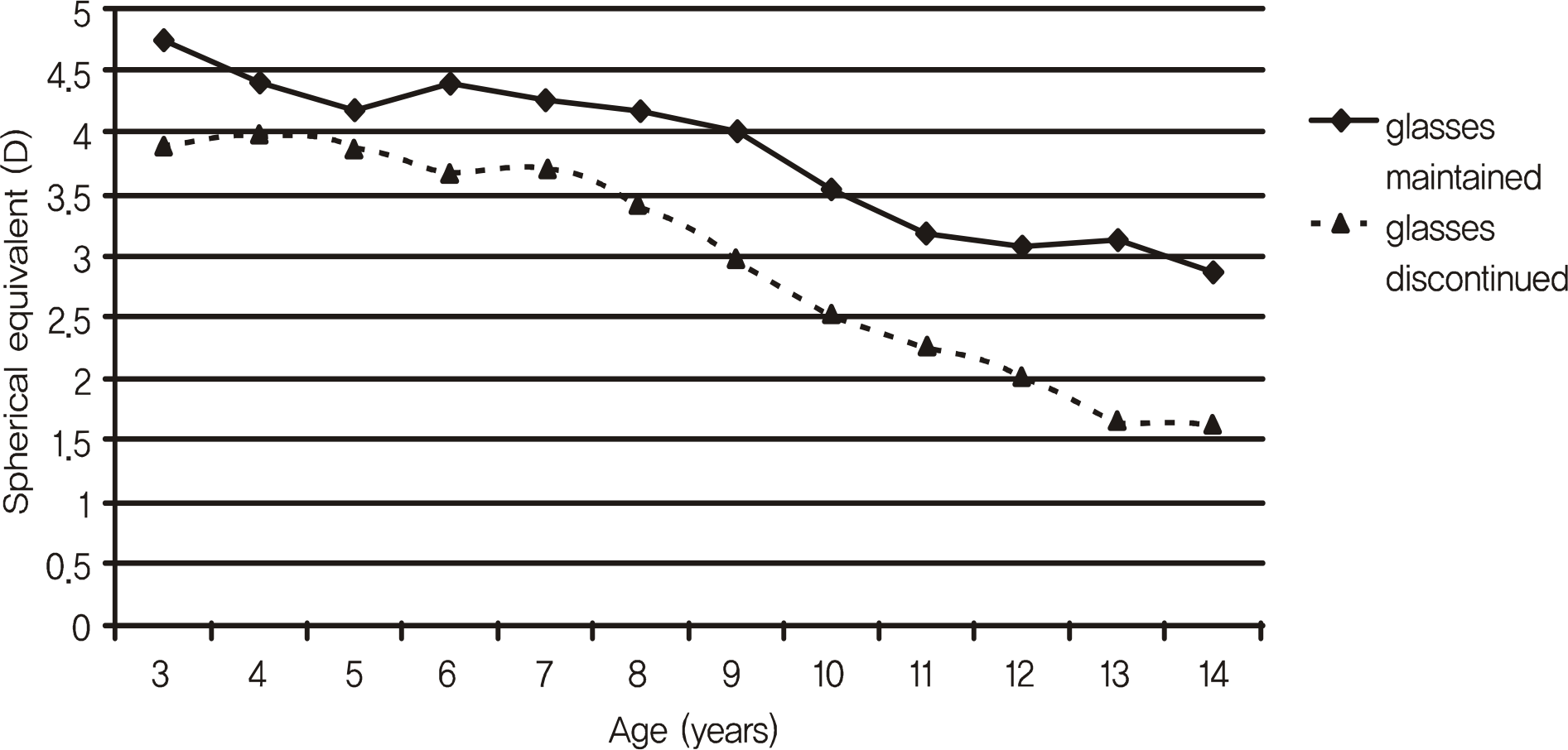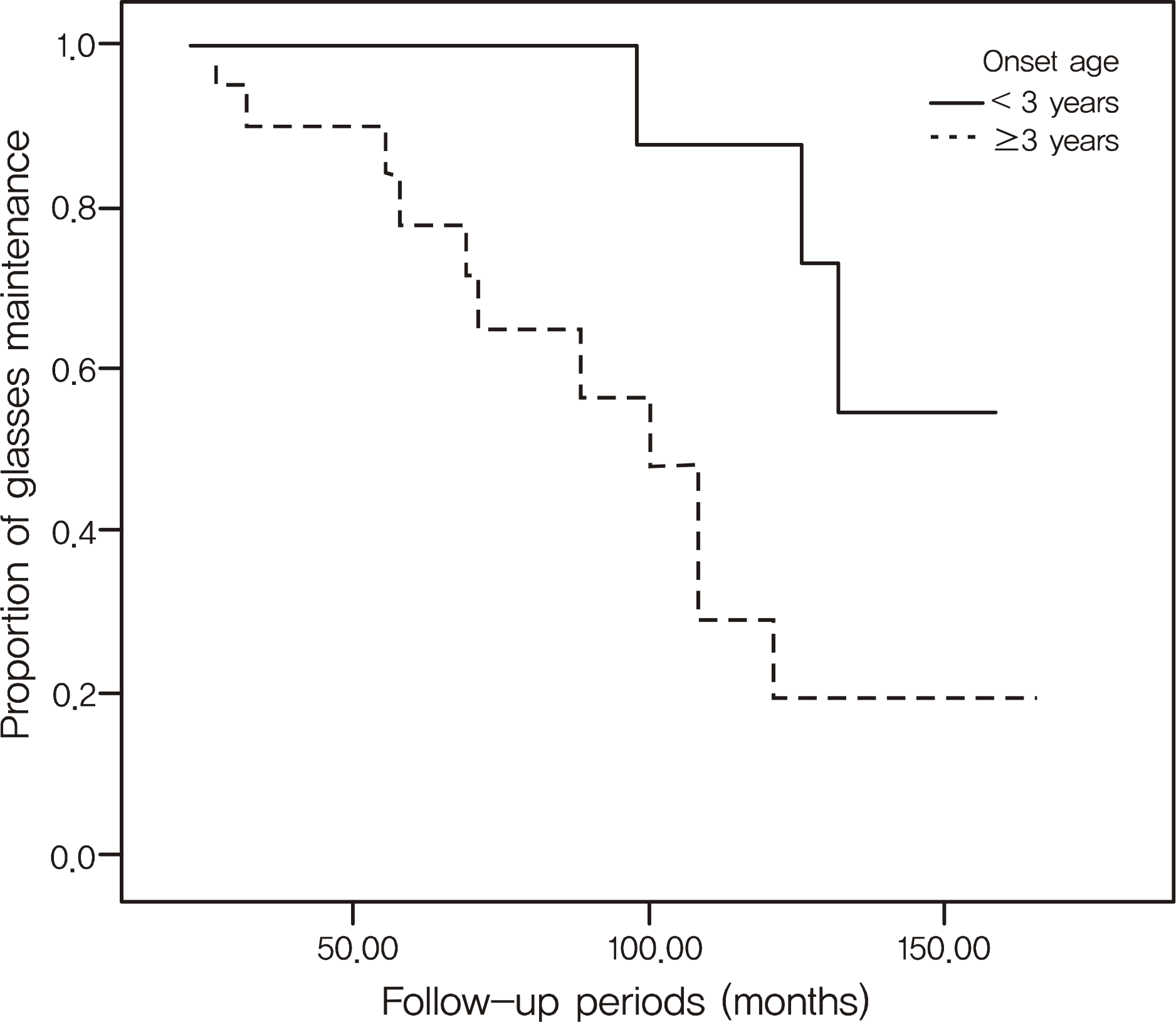Abstract
Purpose
To investigate the predictive factors of successfully weaning children from glasses with accommodative esotropia who were monitored with manifest refraction on followup visits.
Methods
A retrospective review of 48 patients with accommodative esotropia was performed. Weaning was accom-plished by monitoring patients with manifest refraction on followup visits. The patients were divided into 2 groups: patients who were weaned successfully from glasses and patients who still needed glasses at their final visit. A comparative analysis of the multiple clinical features between the 2 groups was performed.
Results
Among the 48 patients, 15 patients were weaned successfully from glasses. The age of onset was significantly different between the 2 groups, 39.6 ± 14.9 months in patients who were weaned successfully from glasses and 30.7 ±16.9 months in patients who still needed glasses. In particular, the patients with onset of accommodative esotropia after 3 years of age were more likely to be weaned from glasses at their final visit.
Go to : 
References
2. Von Noorden GK. Binocular vision and ocular motility. 6th edition.St. Louis: The C.V. Mosby Co;2002. p. 16.
3. Wright KW, Spiegel PH. Pediatric ophthalmology and strabismus. 2nd ed.Springer;2003. p. 13.
4. Rubin SE. Bringing the management of accommodative esotropia into sharp focus. Am J Ophthalmol. 2006; 141:914–5.

5. Repka MX, Wellish K, Wisnicki HJ, et al. Changes in the refractive error of 94 spectacle-treated patients with acquired accommodative esotropia. Binocul Vis. 1989; 4:5–21.
6. Mulvihill A, MacCann A, Flitcroft I, O'keefe M. Outcome in refractive accommodative esotropia. Br J Ophthalmol. 2000; 84:746–9.

7. Hutcheson KA, Ellish NJ, Lambert SR. Weaning children with accommodative esotropia out of spectacles: a pilot study. Br J Ophthalmol. 2003; 87:4–7.

8. Lambert SR, Lynn M, Sramek J, Hutcheson KA. Clinical features predictive of successfully weaning from spectacles those children with accommodative esotropia. J AAPOS. 2003; 7:7–13.

9. Lee TY, Kim MM. Clinical characteristics of accommodative esotropia with successful wearing out of glasses. J Korean Ophthalmol Soc. 2007; 48:1699–705.

10. Hiatt RL, Braswell R, Smith L, Patty JW. Refraction using mydriatic, cycloplegic, and manifest techniques. Am J Ophthalmol. 1973; 76:739–44.

11. Seong GJ, Choi O. Comparison of near retinoscopy, retinoscopy under cycloplegia and subjective refraction. J Korean Ophthalmol Soc. 1987; 28:143–9.
12. Moon NJ, Kim JC, Koo BS. The study on the necessity of cycloplegic refraction in school children. J Korean Ophthalmol Soc. 1988; 29:377–85.
13. Cho YA, Baek SW. Clinical assessment of accommodative esotropia. J Korean Ophthalmol Soc. 1988; 29:371–8.
14. Yang H, Chang YH, Lee JB. Clinical features of refractive accommodative esotropia and partially accommodative esotropia. J Korean Ophthalmol Soc. 2004; 45:626–30.
15. Somer D, Cinar FG, Duman S. The accommodative element in accommodative esotropia. Am J Ophthalmol. 2006; 141:819–26.

16. Raab EL. Hypermetropia in accommodative esodeviation. J Pediatr Ophthalmol Strabismus. 1984; 21:P64–8.
17. Berk AT, Koçak N, Ellidokuz H. Treatment outcomes in refractive accommodative esotropia. J AAPOS. 2004; 8:384–8.

18. Lim SJ, Lee SY, Lee YC. Change of refractive error in patients with refractive accommodative esotropia. J Korean Ophthalmol Soc. 2007; 48:822–7.
Go to : 
 | Figure 1.Comparison of refractive error change between glasses maintained group and glasses discontinued group. The annual changes of the refractive error in 2 groups were not significantly different. |
 | Figure 2.Kaplan-Meier plots of the probability of glasses maintenance in accommodative esotropia patients with its onset before and after 3 years of age. The patients who presented accommodative esotropia after 3 years of age were more likely to be weaned successfully from glasses. |
Table 1.
Clinical characteristics of 48 patients with accommodative esotropia
| Mean ± SD∗ | Range | |
|---|---|---|
| Age at first visit (mon) | 50.2 ± 22.8 | 15-122 |
| Age at onset (mon) | 33.5 ± 16.6 | 0-80 |
| Age glasses prescribed (mon) | 45.2 ± 19.2 | 15-109 |
| Initial distance esodeviation (PD†) | 25.5 ± 12.0 | 10-55 |
| Initial refractive error (D‡) | 4.41 ± 1.37 | 1.50-8.25 |
| Final refractive error (D‡) | 2.93 ± 1.62 | 0.38-7.50 |
| Followup period (mon) | 74.6 ± 42.5 | 24-165 |
Table 2.
Demographics and clinical characteristics of 2 groups
| Glasses maintained | Glasses discontinued | p value∗ | |
|---|---|---|---|
| Gender (Male:Female) | 17:16 | 3:12 | 0.059 |
| Amblyopia, patients (%) | 15 (45.5%) | 8 (53.3%) | 0.613 |
| Age at first visit (mon,, mean ± SD) | 47.8 ± 22.2 | 55.7 ± 23.9 | 0.136 |
| Age at onset (mon,, mean ± SD) | 30.7 ± 16.9 | 39.6 ± 14.9 | 0.043 |
| Age glasses prescribed (mon,, mean ± SD) | 44.2 ± 21.5 | 47.3 ± 13.2 | 0.142 |
| Initial distance esodeviation (PD†, mean ± SD) | 27.2 ± 12.7 | 21.9 ± 9.7 | 0.143 |
| Initial refractive error (D‡, mean ± SD) | 4.59 ± 1.48 | 4.01 ± 1.00 | 0.145 |
| Final refractive error (D‡, mean ± SD) | 3.37 ± 1.62 | 1.97 ± 1.15 | 0.002 |
| Follow up period (mon, mean ± SD) | 69.0 ± 45.5 | 86.9 ± 33.2 | 0.089 |
Table 3.
Percentage of patients according to clinical characteristics who successfully weaned from their glasses
| Characteristics | Number of patients | Successfully weaned (%) | p-value∗ |
|---|---|---|---|
| Age at first visit (yr) | |||
| <4 | 26 | 19.2 | 0.066 |
| ≥4 | 22 | 45.5 | |
| Age at onset (years) | |||
| <3 | 23 | 13.6 | 0.023 |
| ≥3 | 25 | 47.8 | |
| Age glasses prescribed (yr) | |||
| <4 | 30 | 20 | 0.052 |
| ≥4 | 18 | 50 | |
| Initial distance esodeviation (PD†) | |||
| <25 | 26 | 38.5 | 0.355 |
| ≥25 | 22 | 23.8 | |
| Initial refractive error (D‡) | |||
| <4 | 19 | 36.8 | 0.538 |
| ≥4 | 29 | 27.6 |




 PDF
PDF ePub
ePub Citation
Citation Print
Print


 XML Download
XML Download